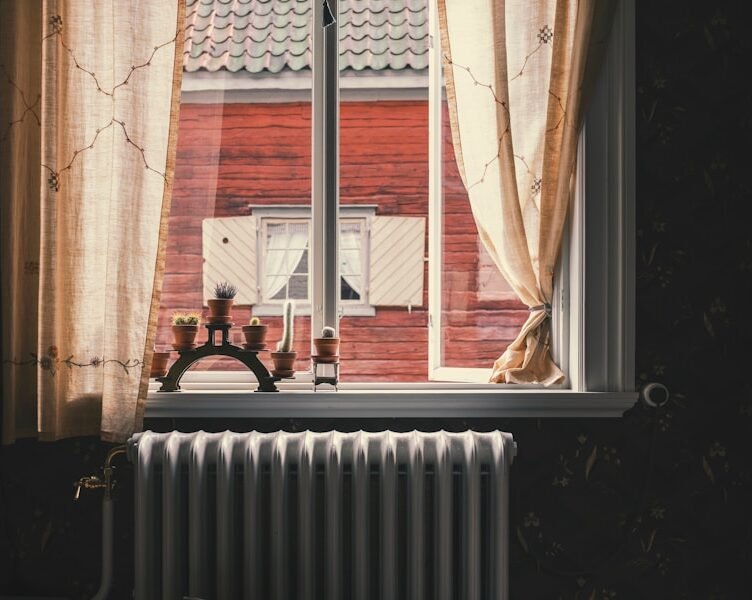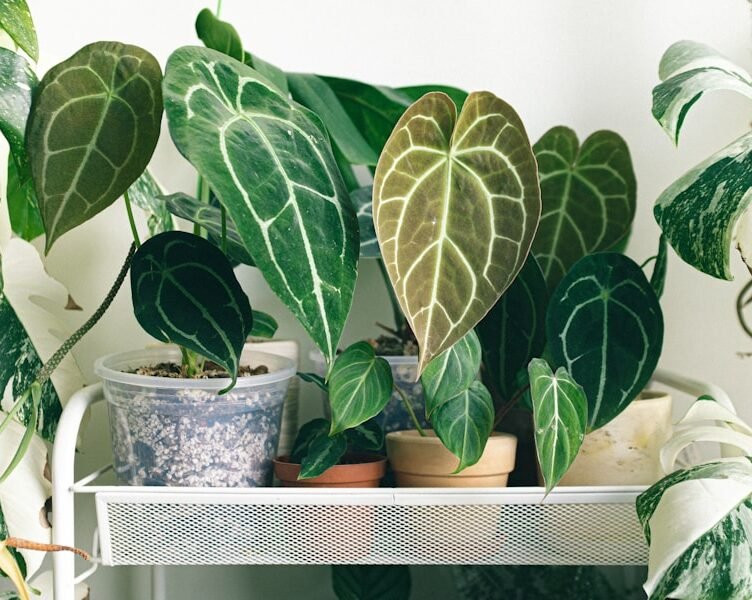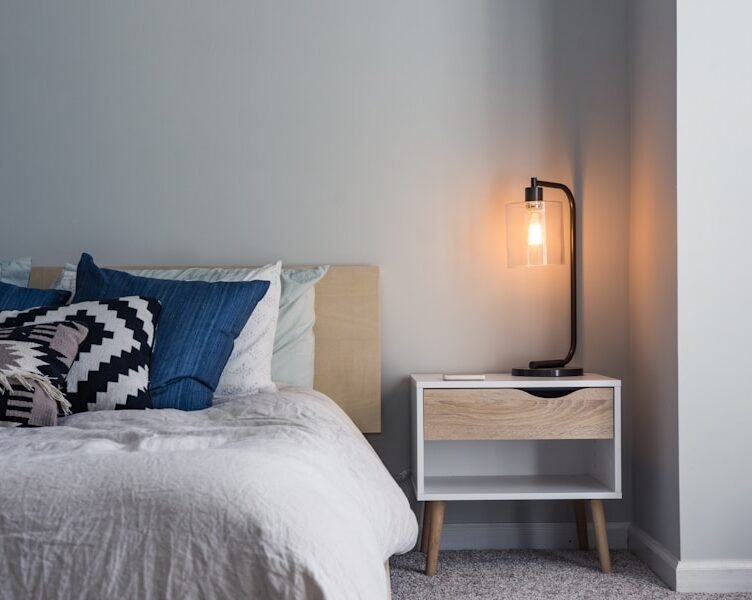When selecting a location for indoor plants in the bedroom to enhance sleep quality, it is crucial to consider the room’s layout and size. Plants should be positioned in areas that receive sufficient sunlight and air circulation, such as near windows or other natural light sources. The size of the plants must also be taken into account to ensure they fit harmoniously into the room’s design.
Large plants can overwhelm small spaces, while smaller plants may become lost in larger rooms. Additionally, the placement of plants in relation to furniture and decor is essential, as they should complement the overall aesthetic of the space without appearing out of place. It is also vital to consider the proximity of plants to the bed.
While indoor plants can improve air quality and create a calming atmosphere, they should not be placed too close to the bed. Some individuals may be sensitive to the scent or pollen of certain plants, which could disrupt sleep. To minimize potential disturbances, it is recommended to place plants on bedside tables, dressers, or shelves at a distance from the bed.
By thoughtfully positioning indoor plants in the bedroom, a peaceful and restful environment can be created, conducive to improved sleep quality.
Key Takeaways
- Place indoor plants in the bedroom to improve sleep quality
- Consider light and temperature when placing indoor plants in the bedroom
- Choose the best types of plants for sleep, such as lavender and jasmine
- Avoid allergens by selecting low-allergy plants and keeping them clean
- Use Feng Shui principles to guide plant placement and create a relaxing atmosphere in the bedroom
Light and Temperature Considerations
Light Requirements
Different plants have varying light needs, so it’s crucial to choose plants that are well-suited for the specific conditions of the bedroom. If the bedroom receives limited natural light, it’s best to choose low-light tolerant plants such as snake plants, pothos, or peace lilies. These plants can thrive in low-light conditions and are well-suited for indoor spaces.
Temperature Requirements
Temperature is another important factor to consider when placing indoor plants in the bedroom. Most indoor plants thrive in temperatures between 65-75 degrees Fahrenheit, which is typically the range for most indoor living spaces. However, it’s important to avoid placing plants near drafts or heating/cooling vents that could create extreme temperature fluctuations.
Humidity Levels
Additionally, it’s important to monitor the humidity levels in the bedroom, as some plants may require higher humidity levels to thrive. By considering these factors, you can create an optimal environment for your indoor plants to flourish.
Overall Health and Longevity
Overall, considering the light and temperature requirements of indoor plants is essential for their overall health and longevity in the bedroom. By choosing the right plants and providing them with the right conditions, you can enjoy the many benefits of having indoor plants in your bedroom.
Best Types of Plants for Sleep
When it comes to choosing the best types of plants for improving sleep quality, there are several options that are known for their air-purifying and calming properties. One popular choice is the snake plant, also known as mother-in-law’s tongue, which is known for its ability to remove toxins from the air and produce oxygen at night. Another popular choice is the peace lily, which not only purifies the air but also adds a touch of elegance with its white blooms.
Additionally, the pothos plant is a great option for improving air quality and is easy to care for, making it a great choice for beginners. Other options for improving sleep quality include lavender, jasmine, and aloe vera plants. Lavender and jasmine are known for their calming and soothing scents, which can help promote relaxation and better sleep.
Aloe vera is also a great choice for improving air quality and has the added benefit of producing oxygen at night. Overall, choosing the best types of plants for sleep involves considering their air-purifying properties, calming scents, and ease of care.
Avoiding Allergens
| Placement | Effect on Sleep Quality |
|---|---|
| Bedroom | Can improve air quality and create a calming environment |
| Near the bed | May increase oxygen levels and promote relaxation |
| On a bedside table | Can add a touch of nature and reduce stress |
| Near a window | Can provide natural light and regulate circadian rhythms |
While indoor plants can have numerous benefits for improving sleep quality, it’s important to be mindful of potential allergens that certain plants may produce. Some people may be sensitive to pollen or scents from certain plants, which could potentially disrupt sleep or cause allergic reactions. To avoid allergens, it’s important to choose plants that are known for their low allergen production, such as snake plants, peace lilies, and aloe vera.
Additionally, it’s important to regularly dust and clean the leaves of indoor plants to minimize any potential allergens that may accumulate. Another way to avoid allergens from indoor plants is to choose plants with minimal pollen production or scents that may be irritating to some individuals. For example, choosing plants with larger leaves and minimal flowers can help reduce potential allergens in the bedroom.
Overall, being mindful of potential allergens when choosing indoor plants for the bedroom is essential for creating a healthy and restful environment conducive to better sleep quality.
Feng Shui and Plant Placement
In addition to their air-purifying properties, indoor plants can also contribute to a positive energy flow in the bedroom according to feng shui principles. When it comes to feng shui and plant placement in the bedroom, it’s important to consider the overall balance and harmony of the space. According to feng shui principles, placing plants in the bedroom can help create a sense of tranquility and promote restful sleep.
However, it’s important to be mindful of the specific placement of plants in relation to furniture and other decor in the room. In feng shui, it’s recommended to place plants in areas that promote positive energy flow, such as near windows or other sources of natural light. Additionally, it’s important to avoid placing plants in areas that feel cluttered or overwhelming, as this can disrupt the overall energy flow in the room.
Overall, incorporating indoor plants into the bedroom according to feng shui principles can contribute to a harmonious and balanced environment that promotes better sleep quality.
Creating a Relaxing Atmosphere
The Calming Effect of Greenery
The presence of greenery in the bedroom can help create a sense of calm and tranquility, reducing stress and promoting relaxation before bedtime. This connection to nature has been shown to have numerous benefits for overall well-being.
Air-Purifying and Calming Properties
In addition to their visual appeal, indoor plants can also contribute to a relaxing atmosphere through their calming scents and air-purifying properties. For instance, plants with soothing scents like lavender or jasmine can promote relaxation and better sleep. Many indoor plants are also known for their ability to purify the air and remove toxins, creating a healthier indoor environment conducive to better sleep quality.
Creating a Restful Sleep Environment
Overall, incorporating indoor plants into the bedroom can help create a relaxing atmosphere that promotes restful sleep and overall well-being. By choosing the right plants and incorporating them into your bedroom design, you can create a peaceful retreat that helps you unwind and recharge for a better night’s sleep.
Maintenance and Care for Indoor Plants in the Bedroom
Once indoor plants have been placed in the bedroom to improve sleep quality, it’s important to establish a regular maintenance routine to ensure their health and longevity. This includes regular watering, pruning, and cleaning of the leaves to keep them looking their best and functioning at their optimal level. It’s important to monitor the moisture levels of the soil and adjust watering frequency as needed based on the specific needs of each plant.
Additionally, it’s important to regularly dust and clean the leaves of indoor plants to minimize any potential allergens or dust buildup that may accumulate over time. This can be done using a damp cloth or sponge to gently wipe down the leaves and keep them looking vibrant and healthy. It’s also important to periodically check for any signs of pests or disease that may affect indoor plants and take appropriate measures to address any issues that arise.
Overall, establishing a regular maintenance routine for indoor plants in the bedroom is essential for their overall health and longevity. By providing proper care and attention, indoor plants can continue to contribute to a peaceful and restful environment conducive to better sleep quality. In conclusion, placing indoor plants in the bedroom can have numerous benefits for improving sleep quality when done thoughtfully and with consideration for light and temperature requirements.
By choosing the best types of plants for sleep, avoiding potential allergens, incorporating feng shui principles, creating a relaxing atmosphere, and establishing a regular maintenance routine, indoor plants can contribute to a peaceful and restful environment conducive to better sleep quality. With careful consideration and proper care, indoor plants can be a valuable addition to the bedroom that promotes overall well-being and contributes to a healthier indoor environment conducive to better sleep quality.
FAQs
What are the best places to put indoor plants for improving sleep quality?
Indoor plants can be placed in the bedroom, on bedside tables, on shelves, or in hanging planters near the bed to improve sleep quality.
Which indoor plants are best for improving sleep quality?
Plants such as lavender, jasmine, aloe vera, snake plant, and peace lily are known for their air-purifying and calming properties, which can help improve sleep quality.
How do indoor plants improve sleep quality?
Indoor plants can improve sleep quality by purifying the air, reducing stress and anxiety, and adding a calming and soothing ambiance to the bedroom environment.
Are there any indoor plants that should be avoided in the bedroom?
Plants that release strong fragrances or allergens, such as certain types of ferns or flowering plants, should be avoided in the bedroom as they may have a negative impact on sleep quality for some individuals.
How many indoor plants should be placed in the bedroom to improve sleep quality?
The number of indoor plants placed in the bedroom to improve sleep quality can vary based on personal preference and the size of the bedroom. It is recommended to have at least one or two plants to experience the benefits.







